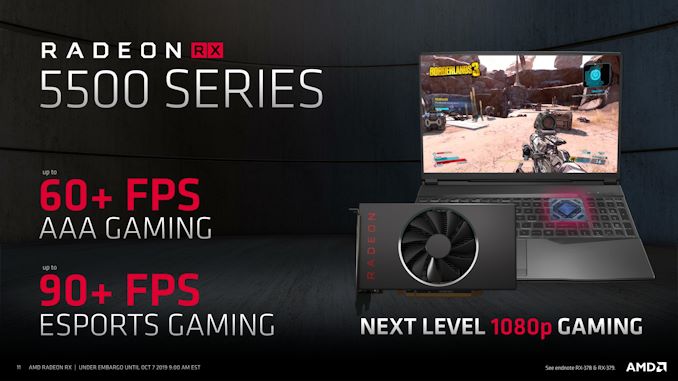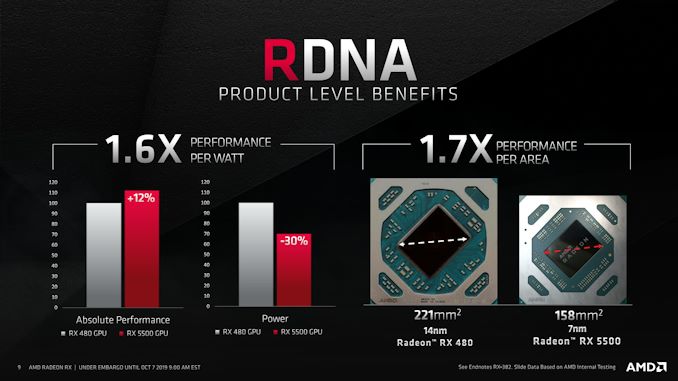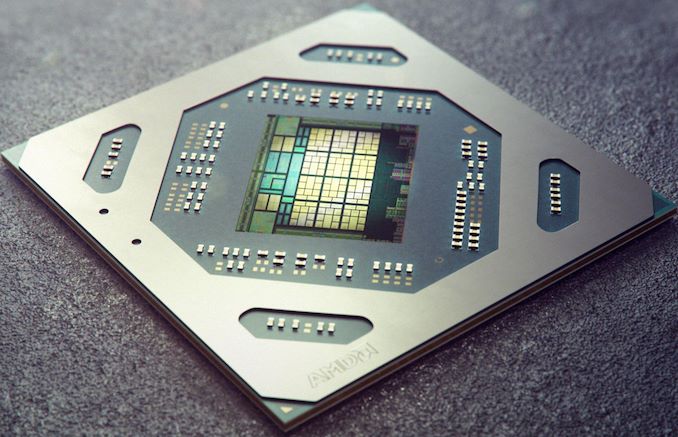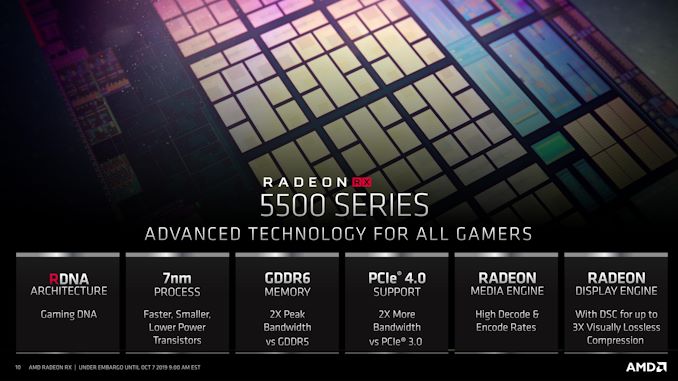AMD Announces Radeon RX 5500 Series: 1080p Gaming for Desktop & Mobile, Coming This Quarter
by Ryan Smith on October 7, 2019 9:00 AM EST- Posted in
- GPUs
- AMD
- Radeon
- Navi
- Radeon RX 5500

Coming off of an incredibly busy summer for AMD that saw some of its most important product launches in recent history across both CPUs and GPUs, AMD is gearing up to finish out the year on a high note as well. This morning the company is announcing the next series in its Radeon RX 5000 family of video cards, the Radeon RX 5500 series. Based on the same RDNA architecture as AMD’s flagship RX 5700 parts, the new RX 5500 series is being built around a new, smaller Navi GPU that will allow AMD to bring their latest Radeon technologies down to more affordable, mainstream video cards, as well as laptops for the first time.
AMD’s announcement follows the usual GPU product cascade that we see in every generation. After launching their pathfinder GPU for a new generation – in this case the Navi 10 GPU and associated Radeon RX 5700 series video cards – AMD is now getting ready to fill in the rest of their GPU/video card product stack with new products to cover the rest of their desired range. AMD so far hasn’t told us how many GPUs to expect in the Navi family, but a normal AMD GPU stack is 3-4 GPUs.
As is often the case, AMD is going straight down the stack. Following this summer’s launch of the Radeon RX 5700 series – and the fanfare that has followed it – AMD is now turning their attention to the market below that. With even the Radeon RX 5700 (vanilla) card starting at $349, there is ample room below the RX 5700 series for AMD to offer cheaper cards for a more mainstream audience, and this is exactly what AMD is setting out to do. The new Radeon RX 5500 series parts will be focusing on 1080p gaming, bringing AMD’s RDNA architecture and features down to that popular, high volume segment of the gaming market.
With all of that said, however – and before we get to the specs and other technical matters – today’s announcement needs to be put in context, as today is not a retail video card launch. In fact, AMD isn’t even announcing exactly when retail cards will show up, beyond a vague Q4. Instead, today’s announcement is essentially about the OEM side of AMD’s product stack. With the holiday buying season already ramping up, AMD’s OEM partners need to announce their holiday system lineups now, and so AMD is announcing almost everything about the Radeon RX 5500 series now rather than having the OEMs steal AMD’s thunder.
To be sure, AMD is giving us plenty of details, including information on the new GPU, clockspeeds, TDPs, and more. But the specifications here are for OEM products, not retail products, and AMD is framing them accordingly. Generally speaking, OEM and retail products don’t differ too much in this product segment – so don’t be surprised if you see a retail Radeon RX 5500 (vanilla) card farther down the line with specifications identical to (If not a bit better than) the OEM card – but context is important, especially as OEMs sometimes underclock things.
Meanwhile, not to be overshadowed, today’s announcement also covers a new mobile part, the Radeon RX 5500M. We’ll get to that part a bit later, but it bears mentioning earlier on because it’s part of a greater shift in product naming for AMD. In short, after spending the last generation with just a single family of products for both desktop and mobile, discrete mobile SKUs are back. The Radeon RX 5500M is the first of these products, and while it is based on the same GPU as the desktop RX 5500 series, it has its own clockspeed, performance, and TDP specifications. None of this really changes how OEMs will be building out their laptops, but if nothing else, it will hopefully make it clearer how their laptops’ GPUs are configured and will perform.
| AMD Radeon RX Series Specification Comparison | ||||||
| AMD Radeon RX 5500 Series (OEM) | AMD Radeon RX 5700 | AMD Radeon RX 480 | AMD Radeon RX 560 | |||
| CUs | 22 (1408 SPs) |
36 (2304 SPs) |
36 (2304 SPs) |
16 (1024 SPs) |
||
| Texture Units | 88 | 144 | 144 | 64 | ||
| ROPs | 32 | 64 | 32 | 16 | ||
| Base Clock | ? | 1465MHz | 1120MHz | 1175MHz | ||
| Game Clock | <=1670MHz | 1625MHz | N/A | N/A | ||
| Boost Clock | <=1845MHz | 1725MHz | 1266MHz | 1275MHz | ||
| Throughput (FP32) | <=5.2 TFLOPs | 7.95 TFLOPs | 5.1 TFLOPs | 2.6 TFLOPs | ||
| Memory Clock | 14 Gbps GDDR6 | 14 Gbps GDDR6 | 8 Gbps GDDR5 | 7 Gbps GDDR5 | ||
| Memory Bus Width | 128-bit | 256-bit | 256-bit | 128-bit | ||
| VRAM | 4GB/8GB | 8GB | 8GB | 4GB | ||
| Transistor Count | 6.4B | 10.3B | 5.7B | 3B | ||
| Typical Board Power | 150W | 180W | 150W | 80W | ||
| Manufacturing Process | TSMC 7nm | TSMC 7nm | GloFo 14nm | GloFo 14nm | ||
| Architecture | RDNA (1) | RDNA (1) | GCN 4 | GCN 4 | ||
| GPU | Navi 14 | Navi 10 | Polaris 10 | Polaris 11 | ||
| Launch Date | Q4 2019 | 07/07/2019 | 06/29/2016 | 05/2017 | ||
| Launch Price | TBD | $349 | $239 | $99 | ||
Starting off with the desktop OEM cards then, we have what AMD is calling the Radeon RX 5500 Series. Based on the new Navi 14 GPU, these cards are aimed at the 1080p market, and in terms of specifications, are largely scaled-down versions of AMD’s Navi 10 cards, the Radeon RX 5700 series.
In terms of CUs, all of these cards will ship with 22 CUs, 14 fewer CUs (-39%) than the next card in AMD’s stack, the Radeon RX 5700. However while the CU counts are down, the clockspeeds will be up slightly, with the RX 5500 Series carrying a maximum game clock of 1670MHz, 45MHz (3%) higher than the RX 5700. Similarly, the maximum boost clock is higher as well, to 1845MHz. With that said, since we are talking about OEM cards, the usual disclaimer applies: these are “up to” frequencies, and OEMs may dial down the clockspeeds for power and other reasons. Officially there are no minimum clockspeeds for OEM configurations, so it remains to be seen what OEMs decide to do.
In terms of overall GPU performance then, at full clockspeeds the RX 5500 Series will have a peak compute/shader throughput of 5.2 TFLOPs. This is 35% below the peak rate of the RX 5700, and is fairly typical for the kind of jump we see between card tiers.
Meanwhile on the memory side of matters, the RX 5500 Series gets a narrower memory bus as well. Coming off of the RX 5700 series and its 256-bit bus, AMD’s mainstream cards will instead come with a 128-bit memory bus. However, that is the only change for memory; AMD will be using GDDR6 for these cards as well. So while the effective drop in memory bandwidth relative to the RX 5700 is significant – going from 448GB/sec to 224GB/sec – it will be the first time that GDDR6 has shown up in a mainstream video card. As a result, the RX 5500 Series will still have access to a good deal of memory bandwidth, and in this respect should punch above its weight compared to earlier 128-bit bus cards. As for total memory capacity, the cards will support up to 8GB of VRAM, however this is another “up to” specification and OEMs may decide ship some systems with 4GB configurations as well.
Finally, while it’s not listed in AMD’s official tables, the company has told me that the TGP for these cards will be 150W. This surprised me a bit, and I’m curious to see if AMD is just being conservative here for OEMs, or if real-world power consumption really will be that high. To put things in perspective here, the Radeon 5700 (vanilla) is a 180W card, so a 150W TGP is only around 17% lower than the next card up in AMD’s stack, for a performance difference I expect to be greater than that. Or, looking at last-generation cards, this would give the RX 5500 series a TGP comparable to the Radeon RX 480 & 570. If these TGPs are accurate, then this may be another case of AMD favoring absolute performance over performance efficiency for their mainstream parts, which was also the case with the high-end Radeon RX 500 series cards in the previous generation.
In terms of performance expectations then, AMD is only offering a few numbers so far. The company says that the new RX 5500 Series cards still deliver an even better efficiency improvement than their RX 5700 series cards, with a 1.6x improvement in performance-per-watt over AMD’s last-generation cards. Comparing the new card to the RX 480, AMD is touting a 30% drop in power consumption coupled with a 12% increase in absolute performance. Do note however that AMD’s figures are literally labeled “GPU”, which implies that we are looking at just GPU figures rather than whole card figures.
Elsewhere, AMD is posting gaming figures in recent games at 1080p Medium, with gains over the RX 480 in the 15-20% range.
Even a 12% increase in absolute performance over the RX 480 would mean that the RX 5500 Series cards will perform very similarly to the higher-end parts from AMD’s Radeon RX 500 series. The black sheep of that family, the RX 590, delivered about 15% better performance than the RX 480, so if AMD’s figures are accurate, then the RX 5500 Series will land in between the RX 580 and RX 590, coming in just short of the latter. Which if AMD can deliver that kind of performance at 150W, would be a significant improvement over the power-hungry RX 590.
Otherwise, the rest of AMD’s performance estimates are against NVIDIA’s GeForce GTX 1650, which of course AMD handily wins. However without pricing information, I’m not reading too much into those figures, as the GTX 1650 is a $149 card, and I’d be surprised to see AMD go quite that low when they’re promoting a 30-35% performance advantage.
Navi 14: Navi, But Smaller
Now that we’ve seen the specs for the desktop OEM cards, let’s take a quick look at the Navi 14 GPU itself. Destined to power AMD’s RX 5500 desktop and mobile parts, Navi 14 is a very typical slimmed-down version of AMD’s leading-edge technology.
In terms of die size and transistor counts, AMD has dropped about 3.9B transistors from Navi 10, which comes to 38% fewer transistors overall. This translates into a die size of 158mm2, an almost perfectly matched 37% smaller than Navi 10. Compared to AMD’s previous generations of parts comparisons are a bit rocky since performance targets and die sizes have gone up overall, but this works out to a transistor count about 12% higher than Polaris 10/20/30, in just 70% of the space. Polaris 11 (used in RX 460/560) might be a more apt comparison here, in which case AMD has increased their transistor count by 113% while only increasing the die size by 28%.
These improvements come thanks to TMSC’s 7nm process, of course. The heart of AMD’s entire next-generation product stack across CPUs and GPUs for 2019, AMD is once again using this process for their latest Navi GPU. This remains a critical edge for AMD on a competitive basis, as NVIDIA is still using TSMC 12nm – a 16nm-derrived process – for their GPUs. This gives AMD the ability to lay down smaller transistors operating at lower power levels, with the trade-off being that 7nm is a younger, more expensive process. And, if reports are to be believed, one that TSMC’s customers are jockeying to secure wafer starts due to very high demand.
| AMD GPUs | ||||||
| Navi 14 | Navi 10 | Polaris 10 | Polaris 11 | |||
| CUs | 24? | 40 | 36 | 16 | ||
| Texture Units | 96? | 160 | 144 | 64 | ||
| ROPs | 32 | 64 | 32 | 16 | ||
| Memory Interface | GDDR6 | GDDR6 | GDDR5 | GDDR5 | ||
| Memory Bus Width | 128-bit | 256-bit | 256-bit | 128-bit | ||
| Die Size | 158mm2 | 251mm2 | 221mm2 | 123mm2 | ||
| Transistor Count | 6.4B | 10.3B | 5.7B | 3B | ||
| Manufacturing Process | TSMC 7nm | TSMC 7nm | GloFo 14nm | GloFo 14nm | ||
| Architecture | RDNA (1) | RDNA (1) | GCN 4 | GCN 4 | ||
Drilling down, according to AMD the RX 5500 Series of cards are not using a fully-enabled Navi 14 GPU. The company isn’t clarifying just what a fully-enabled GPU is, but RX 5500 and its 22 CUs isn’t it. Given what we know about die sizes, AMD couldn’t have fused off too many units here, so it’s a fair assumption that a full Navi 14 GPU will come with 24 or 26 CUs. Assuming in turn that the RX 5500 Series comes to the retail desktop as a multi-card product stack, and that the OEM RX 5500 Series becomes an RX 5500 (vanilla), then using a cut-down part here means AMD can use a fully-enabled part for a Radeon RX 5500 XT, should the need arise.
Otherwise, Navi 14 is a full-fat Navi GPU in terms of architecture and features. AMD has confirmed that it’s the full RDNA (1) architecture, which means that it includes support for PCIe 4.0 as well as AMD’s new display processing (Radeon Display Engine) and video processing (Radeon Media Engine) blocks. The display block, in turn, is being cut down ever so slightly from 6 pipelines to 5 – meaning that Navi 14 can support up to 5 monitor streams – but is otherwise identical in terms of support for DisplayPort 1.4, Display Stream Compression, etc. Meanwhile the video processing block remains entirely unchanged from Navi 10 and should offer the same encode and decode performance as AMD’s higher-end cards. So, if AMD really does price the Radeon RX 5500 series against NVIDIA’s GeForce GTX 1650, expect to see AMD wield this against NVIDIA on a regular basis, since the GTX 1650 (TU117) came with an older, less advanced video block from Volta.














61 Comments
View All Comments
yankeeDDL - Monday, October 7, 2019 - link
I have an R9 270x. How do I know how does it compare with the RX 5500 in terms of absolute performance? (I am sure that in perf/watt there's no story).Smell This - Monday, October 7, 2019 - link
The R9 270X (or, Radeon HD 7870) is the GCN 1.0 "Southern Islands" generation derivative. Through the miracles of extrapolation when compared to the Radeon 5700 series (and 6 years of *advancement*), I will guess 2X the performance, AND ...It's amazing that the Radeon RX 5500 series effectively becomes your discrete, entry-level gaming card for the masses. Shazzzam.
As noted, this would be "Video Core Next" (VCN 1.0) of the "Unified Video Decoder" or, the original ATI "Avivo" (if I remember correctly ...)
schujj07 - Monday, October 7, 2019 - link
Considering the 290X "Uber" is 50-100% faster than the 270X and the RX 580 is 0-15% faster than the 290X "Uber" then the RX 5500X will be 50-125% faster than your 270X easily.Beany2013 - Monday, October 7, 2019 - link
I've got an R280 (effectively a rebranded...7970? I think) and my demands aren't high - 1080p, mostly older games. Running linux (and thus not having Vulkan support on the 280...) one of these may do very nicely to keep me vaguely in the loop.mikato - Monday, October 21, 2019 - link
You could maybe also find a nice RX 580 8GB that was previously used for cryptocoin mining for $100. That might be better if this RX 5500 is going to be over $150, but similar performance to RX 580/590.quadibloc - Monday, October 7, 2019 - link
There's also no story in FP64 performance: there, your older card is likely to be 'way ahead. If, of course, that is important to you. No, I'm mistaken: the R9 290X had impressive FP64 performance that current cards don't match, but that didn't extend down to the 270 and 270X.ballsystemlord - Tuesday, October 8, 2019 - link
The new cards have buggy and poor OpenCL drivers. Their HW is also said to be inferior with respect to the FP64 metrics. Buyer beware.Demiurge - Wednesday, October 9, 2019 - link
Just buy a Radeon VII and develop the ocl driver implementation with the GitHub folks. You get what you pay for...Also, just look up what a Tesla V100 costs for giggles. Look at the power and FP64 of Tesla K80 as a reference. You may appreciate being able to even have new GPU FP64 rates for the order of magnitude in cost difference.
juergbi - Monday, October 7, 2019 - link
https://www.amd.com/en/products/graphics/amd-radeo... lists TBP as 110W, not 150W.chilidogs - Monday, October 7, 2019 - link
where are you seeing that? currently showing "Requirements Typical Board Power (Desktop) 150WPSU Recommendation 550W